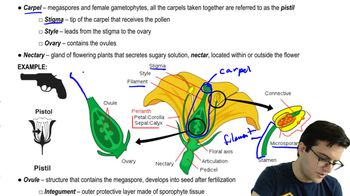Textbook Question
The innermost layer of the root cortex is the a. core. b. pericycle. c. endodermis. d. pith.
523
views
 Campbell 11th Edition
Campbell 11th Edition Ch. 35 - Vascular Plant Structure, Growth, and Development
Ch. 35 - Vascular Plant Structure, Growth, and Development Problem 5
Problem 5 Verified step by step guidance
Verified step by step guidance



The innermost layer of the root cortex is the a. core. b. pericycle. c. endodermis. d. pith.
Heartwood and sapwood consist of a. bark. b. periderm. c. secondary xylem. d. secondary phloem.
The phase change of an apical meristem from the juvenile to the mature vegetative phase is often revealed by a. a change in the morphology of the leaves produced. b. the initiation of secondary growth. c. the formation of lateral roots. d. the activation of floral meristem identity genes.
Which of the following arise(s), directly or indirectly, from meristematic activity? a. secondary xylem b. leaves c. dermal tissue d. all of the above